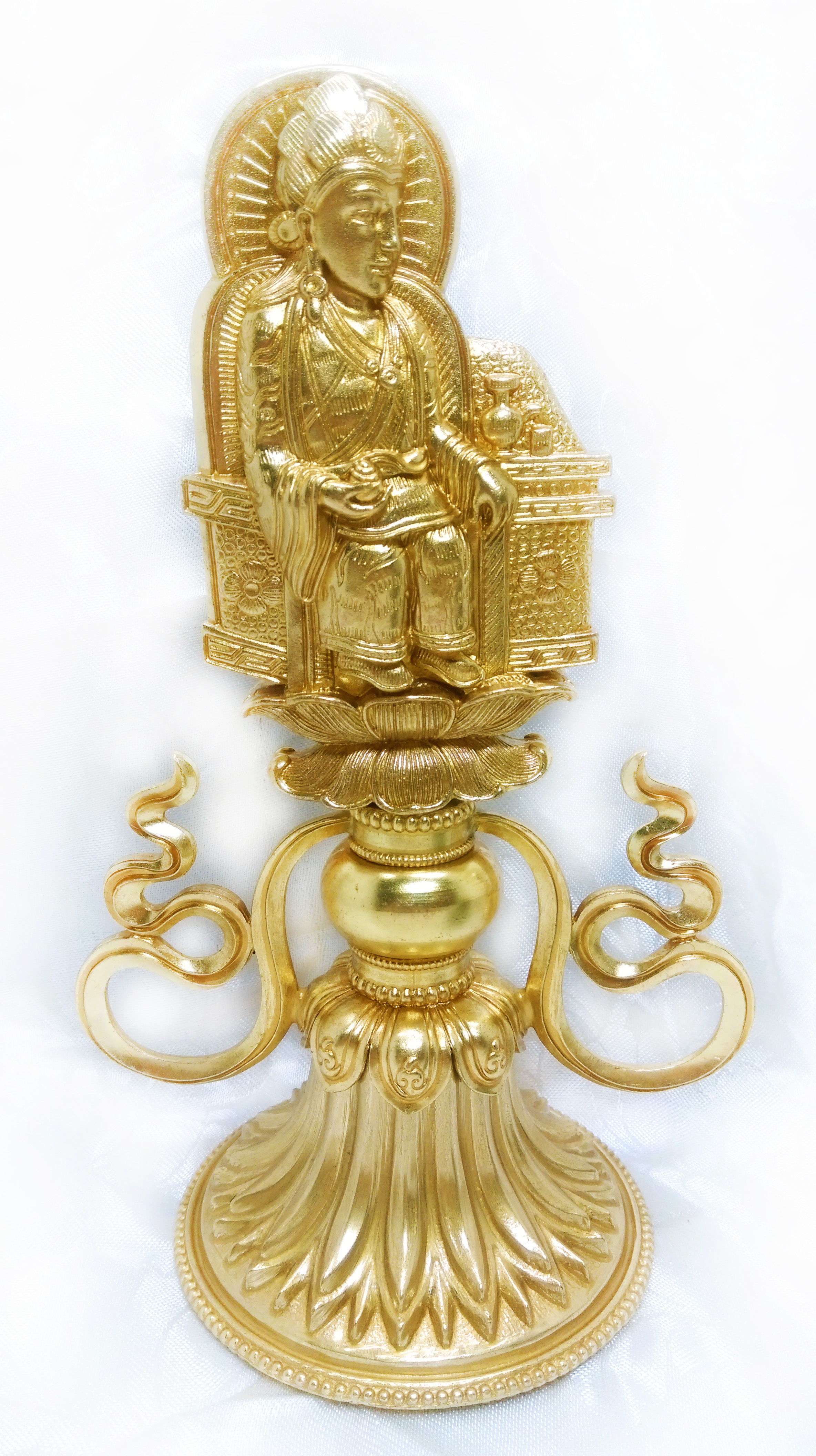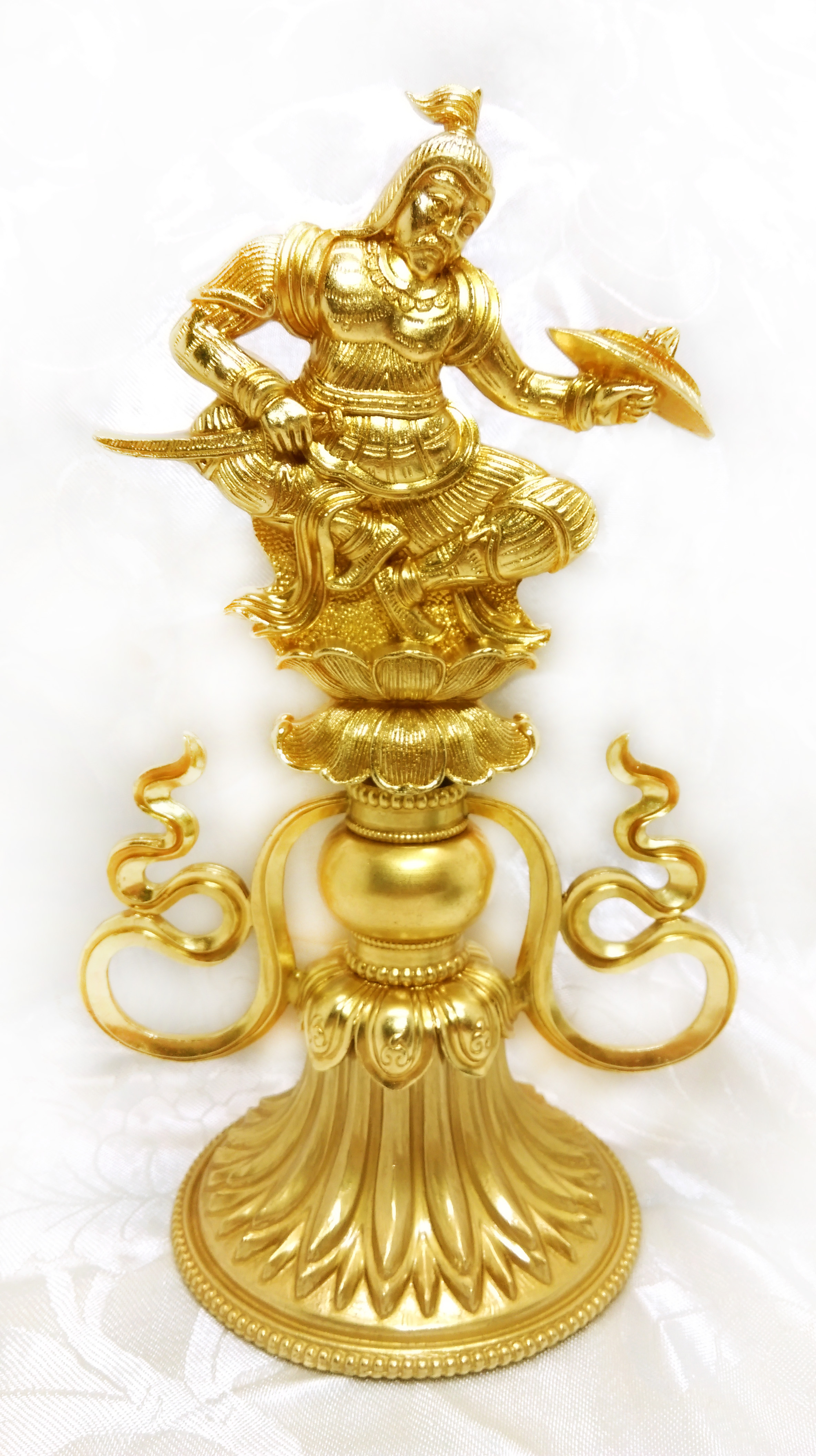|
|
|
Wholesalers: |

|
/ |
|
|
|
|
|
|
|
|
| "To keep the body in good health is a duty, for otherwise we shall not be able to trim the lamp of wisdom, and keep our mind strong and clear. Water surrounds the lotus flower, but does not wet its petals." Shakyamuni Buddha (563-483 B.C.) |
|
|
|
|
|
|
|
|
|
|
|
|
|
|
|
|
|
|
|
| Seven precious (Double sided Sterling brass) |
|
|
|
|
|
Sku#:536-7-PreciousA
|
|
|
Wholesale price |
US |
XXX.XX |
|
《In order to view the wholesale price .
Please Apply to be a wholesalers》
|
|
|
|
|
 |
|
Please contact us to verify availability. 1-626-354-6228
Email: zambalallc@gmail.com
America area customers can view on this website first.
https://FlyingMystics.org/ |
|
|
|
|
|
|
Materials: Pure copper, electroplated, cast, painted
Dimensions: Approximately 20.5 cm in height
Description:
An Overview of the Seven Treasures in Buddhism
The Seven Treasures (also known as the Seven Treasures of the Wheel King or the Seven Treasures of the Wheel-Turning King) are seven precious objects described in Buddhist texts. Originating from Indian Buddhist traditions, they were later introduced to Chinese and Tibetan Buddhism. They not only symbolize worldly power and abundance but also carry deep spiritual significance, representing the divine authority of the Wheel-Turning King (Cakravartin, meaning "Wheel-Turning King" in Sanskrit) to rule the world. In Buddhist rituals, the Seven Treasures are often used as offerings, particularly in Tibetan Buddhist mandala arrangements, mind offerings, and ceremonies. They symbolize the dedication of the entire land and power to the Buddha, praying for world peace and the continued rotation of the Dharma. These treasures are typically made of metal, gemstones, or symbolic objects (such as turquoise and agate) and placed at the center of an altar or mandala as a medium for visual and spiritual offering.
The specific composition of the Seven Treasures is shown in the table below (based on the "Sutra on the Seven Treasures of the Wheel King"):
| Treasure Name | Description and Symbolism |
|----------|------------|
| **Wheel Treasure (Golden Wheel Treasure)** | A thousand-spoked golden wheel descends from the sky, symbolizing royal power and the Dharma, capable of conquering all directions and unrivaled. It corresponds to the "Judgement of the Dhamma," helping one discern the true Dharma. |
| **Elephant Treasure** | A pure white elephant, immensely powerful, capable of carrying a thousand loads, symbolizes stability and strength. It corresponds to the "Equanimity," helping one to let go of greed and attachment. |
| **Horse Treasure** | A swift divine horse (often in blue, yellow, red, and white) that can travel a thousand miles a day, symbolizes speed and wisdom. It corresponds to the "Energy," encouraging diligent practice. |
| **Queen Treasure (Female or Concubine Treasure)** | A beautiful and virtuous queen, endowed with supernatural powers and wisdom, symbolizes harmony and rule. It corresponds to the "Joy," bringing inner joy. |
| **Minister Treasure (Wealth Minister Treasure)** | This symbolizes the wisdom and wealth aspect, generating endless wealth and symbolizing economic prosperity. It corresponds to the "ease and tranquility" factor of enlightenment, bringing ease and comfort to the body and mind. |
| **General Treasure** | This symbolizes a brave general, invincible on the battlefield, symbolizing military might. It corresponds to the "concentration" factor of enlightenment, helping one achieve concentration. |
| **Mani Treasure (Jewel)** | This symbolizes the wish-fulfilling jewel, fulfilling all wishes and illuminating darkness, symbolizing liberation and light. It corresponds to the "equanimity" or "mindfulness" factors of enlightenment, awakening mindfulness. |
These treasures are not merely material symbols; they also correspond to the Buddhist "Seven Factors of Enlightenment" (discerning the Dharma, effort, rapture, ease and tranquility, mindfulness, concentration, and equanimity), representing the path to enlightenment that overcomes obstacles to practice.
Role in Buddhist Ritual
In Buddhist rituals, the Seven Jewels play multiple roles, primarily as offerings, protection, and symbolic functions:
1. **Offerings and Mandala Arrangements**: In tantric Tibetan Buddhist rituals (such as visualization offerings and fire pujas), the Seven Jewels are considered core elements of "visual offerings." Practitioners visualize these treasures and offer them to the deity or the Three Jewels, symbolizing the unconditional offering of the kingdom's power, wealth, and military might to the Dharma. This helps accumulate merit and pray for peace and harmony within the realm. For example, in mandalas, they are often placed centrally alongside the Eight Auspicious Symbols, enhancing the solemnity of the ceremony.
2. **Protective and Symbolic of Royal Authority**: The Seven Jewels represent the "seven powers" of the Chakravartin, used to protect the Dharma. Historically, during the reign of Empress Wu Zetian, they were incorporated into political rituals to symbolize the ruler's adherence to Buddhist kingship and the preservation of the Buddhist cause. In modern temples, such as the Kagyu Monastery in Taiwan or in exhibitions at the National Palace Museum, the Seven Treasures are often depicted in metal or gemstone carvings, used in ceremonies and exhibitions to remind believers that worldly power should serve the path to liberation.
3. **Spiritual Practice Tools**: By visualizing the Seven Treasures, practitioners can align themselves with the Seven Factors of Enlightenment and overcome defilements such as greed, hatred, and ignorance. For example, the Chakravartin helps discern the Dhamma, while the Mani Treasure awakens mindfulness, thereby enhancing the depth of meditation during rituals. They are also often used in simplified forms (such as the Seven Treasures vase) in daily incense offerings or at home altars as auspicious objects.
Overall, the Seven Treasures are not only a visual focal point for rituals but also bridge worldly power and transcendental liberation, teaching believers to uphold the Dhamma with a kingly heart.
Origin of the Seven Treasures
The origins of the Seven Treasures can be traced back to early Buddhist texts, particularly the Sutra of the Seven Treasures of the Wheel-Turning King (also known as the Sutra of the Wheel-Turning King), which describes the miraculous phenomena associated with the birth of a Wheel-Turning King. In Vedic and Buddhist traditions of India, a chakrakarn is a worldly ruler endowed with great merit. His appearance marks the beginning of a "Kalpa of Virtue," or a period of peace and prosperity. Upon his birth, his immeasurable virtues inspire the gods, and the Seven Treasures descend from the heavens, naturally manifesting without human intervention. These treasures possess miraculous powers, automatically fulfilling the king's wishes: the chakrakarn conquers enemy states, elephants and horses transport military supplies, ministers assist in government affairs, and the Mani generate endless wealth.
This concept, introduced from India to China, was incorporated into both Han and Tibetan Buddhism. During the Tang Dynasty, Empress Wu Zetian proclaimed herself the "Church-Turning King" and used the Seven Treasures as political symbols to bolster the legitimacy of her rule. In Tibetan Buddhism, these seven treasures evolved into ritual offerings, emphasizing "mental offerings" over material things, embodying the Vajrayana concept of vision.
Stories Related to the Seven Treasures
Stories of the Seven Treasures primarily revolve around the mythological narratives of the chakrakarn king and are found in Buddhist texts such as the Avatamsaka Sutra and the Maharatnakara Sutra. The following is a synopsis of the core story:
During the distant Kalpa of Virtue, whenever the human world was in turmoil, Shakyamuni Buddha's previous bodhisattva incarnation would be reborn as a sage wheel-turning king (such as the Iron Wheel King, the Golden Wheel King, or four other types, ruling over four or one continent). The story exemplifies a wheel-turning king named "Moonlight King": Born in the kingdom of Kausavi, the king possessed the thirty-two characteristics of a great man and possessed boundless merit. When the king reached the age of sixteen and ascended the throne, the sky suddenly shone with golden light, and a thousand-spoked golden wheel descended from the void. The wheel jewel automatically rotated, emitting the sound of "the wheel of Dharma turning constantly." Holding the wheel jewel, the king led the jewel elephants carrying military supplies and the jewel horses galloping across thousands of miles, instantly conquering the four vassal states without a fight, rendering them all subservient.
Then, the jewel ministers appeared, creating endless treasures for the king, filling the treasury; the jewel general led the army to protect the borders, making him invincible; the jewel queen (the jewel king) assisted him with wisdom, maintaining harmony within and without; and the jewel Mani hung in the palace, illuminating the darkness and fulfilling the wishes of the people. With these seven treasures, the king ruled the "Four Continents" (Dongsheng Shenzhou, Nanshanbuzhou, Xiniuhezhou, and Beijuluzhou). Peace reigned supreme, people's lifespans increased, and there was no banditry or war. The king further upheld Buddhism, built temples, and spread the Dharma widely. He ultimately met Shakyamuni Buddha, at which point he abandoned his throne and attained enlightenment.
This story symbolizes the transformation of merit into wisdom: the worldly power of the chakravartin ultimately leads to transcendental liberation, while the seven treasures remind practitioners that worldly wealth, if used for the Dharma, becomes the means for liberation. In Tibetan Buddhism, this story is often incorporated into thangka paintings or murals. For example, the dragon and phoenix throne painting at the Xialu Monastery during the Yuan Dynasty depicts the seven treasures surrounding the throne, emphasizing the integration of royalty and Buddhism.
Through these elements, the seven treasures serve not only as a magnificent embellishment for Buddhist rituals but also as a moral allegory, guiding believers to awaken their true nature from the trappings of power.







|
|
|
 |
|
|
|
|
|
|
|
|
|
|
|
|
|
|
|
|
© 2025 Zambala inc. All Rights Reserved. No part of this site may be reproduced without our written Permission.
Service Mail: ZambalaLLC@gmail.com
Phone: (626) 289-9787 or 1(888)Zambala (926-2252)
Fax: (626) 289-9719
1904 West Valley Blvd. Alahambra, CA 91803 USA
Unless stated otherwise in content's license. Design By
|
|
|